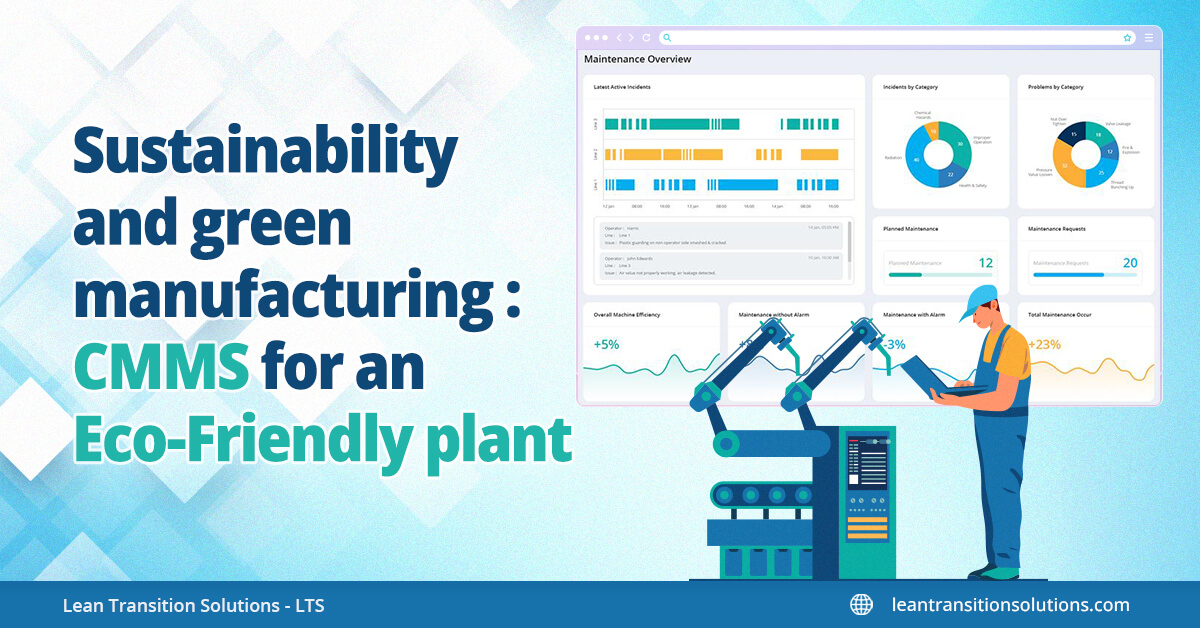Sustainability and Green Manufacturing: CMMS for an Eco-Friendly Plant
January 27, 2025
Manufacturing bears a particular responsibility for environmental impact, even though it is a pressing concern for all industries. Extensive resource usage, heavy calls for energy, and the potential for significant waste have led manufacturers to incorporate sustainability as a virtue and a competitive strategy.
Computerised Maintenance Management System (CMMS) being a powerful, often overlooked tool in the green manufacturing toolkit, helps manufacturing organisations to cut waste, reduce energy and make eco-conscious and smarter decisions by optimising maintenance and asset management. Here is how your plant can use CMMS towards a more sustainable and environmentally friendly future for business advantage and obligation.
Computerised Maintenance Management System (CMMS) being a powerful, often overlooked tool in the green manufacturing toolkit, helps manufacturing organisations to cut waste, reduce energy and make eco-conscious and smarter decisions by optimising maintenance and asset management. Here is how your plant can use CMMS towards a more sustainable and environmentally friendly future for business advantage and obligation.
The Environmental Cost of Maintenance Mismanagement
Did you know? Manufacturing industry consumes almost one-third of entire global energy. Energy waste results from outdated, inefficient equipment systems, machine breakdowns, and reactive breakdown maintenance. All these factors can be addressed by an effective CMMS. In addition to the tracking of and scheduling for preventive maintenance activities, a comprehensive CMMS also generates data on energy consumption, equipment performance productivity and waste disposal, therefore making it a crucial component of green manufacturing strategies. Operating sustainability is not only good for the plant but also reduces business costs.
How does CMMS provide you with a Green Manufacturing Checklist?
To help you kickstart your sustainability journey, here’s a Green Manufacturing Checklist with ways to optimise eco-friendly practices using CMMS.
1. Monitor Energy Usage
CMMS collects and records energy usage information for the various pieces of equipment. It then compares today’s performance to previous data to uncover problems and identify the equipment needing optimisation and improvement.
2. Optimise Preventive Maintenance
By ensuring equipment undergoes a routine check and diagnosing any potential problem, the CMMS prevents a costly repair of equipment in future. Preventive maintenance reduces the number of breakdowns, lowers emergency repair occurrences, and decreases energy expenditure.
3. Implement Predictive Maintenance
Using CMMS for all maintenance activities aids in generating predictive analytics to estimate when particular equipment is more likely to break down. Predictive maintenance eliminates unnecessary replacements and makes you replace only when it is required, thus saving on resources.
4. Reduce Waste in Inventory
CMMS can assist in controlling inventory so that you do not overstock on parts and materials, ensuring you only order what’s needed. This method saves both resources, and it is cost-efficient in terms of disposal.
5.Document Environmental Impact
Take advantage of the key features offered by the CMMS to record and report on the energy and materials consumed by your facility in the long run. Sustainability reports can be used to measure the effect and make progress, enhancing the metrics’ efficacy.
1. Monitor Energy Usage
CMMS collects and records energy usage information for the various pieces of equipment. It then compares today’s performance to previous data to uncover problems and identify the equipment needing optimisation and improvement.
2. Optimise Preventive Maintenance
By ensuring equipment undergoes a routine check and diagnosing any potential problem, the CMMS prevents a costly repair of equipment in future. Preventive maintenance reduces the number of breakdowns, lowers emergency repair occurrences, and decreases energy expenditure.
3. Implement Predictive Maintenance
Using CMMS for all maintenance activities aids in generating predictive analytics to estimate when particular equipment is more likely to break down. Predictive maintenance eliminates unnecessary replacements and makes you replace only when it is required, thus saving on resources.
4. Reduce Waste in Inventory
CMMS can assist in controlling inventory so that you do not overstock on parts and materials, ensuring you only order what’s needed. This method saves both resources, and it is cost-efficient in terms of disposal.
5.Document Environmental Impact
Take advantage of the key features offered by the CMMS to record and report on the energy and materials consumed by your facility in the long run. Sustainability reports can be used to measure the effect and make progress, enhancing the metrics’ efficacy.
Key Features of CMMS and its Impact on Sustainability
Understand how CMMS serves as a backbone for sustainable manufacturing through its key features and its impact on sustainability. Look at the example given below.
| CMMS feature | Example for its impact on Sustainability |
|---|---|
| Predictive Maintenance | Automatic scheduling of maintenance prevents waste from poor-quality outputs produced by malfunctioning equipment |
| Preventive Maintenance | Lower excessive energy consumption resulting in significant cost savings |
| Asset Management | Reduce energy load, minimise resource consumption and operational costs |
| Inventory Management | Make a Just-In-Time (JIT) approach that reduces the environmental impact of excess inventory |
| Mobile Maintenance Management | Digitalise the work orders and eliminate paperwork that ensures eco-friendly operations |
| Total Productive Maintenance (TPM) | Extend the equipment's useful life by making alerts to inspect high-wear areas |
| Compliance and Reporting | Generate insights for eco-conscious decision-making |
Practices to ensure a successful partnership between Maintenance and Sustainability
- Create a comprehensive strategy that synchronises the adoption of CMMS with your sustainability goals.
- Tailor your CMMS to emphasise the most important aspects of sustainability objectives.
- Provide training courses for your users to understand CMMS features and focus on how their efforts relate to the organisational sustainability goals.
- Establish a system for continuing observation and assessment of sustainability metrics and CMMS performance.
- Benchmark and share your success stories to create a positive feedback loop and boost morale.
Why an Eco-Friendly Manufacturing Plant needs CMMS?
In today’s environmentally conscious business environment, CMMS isn’t an application; it is a competitive edge that guides manufacturers to a greener tomorrow. Through green manufacturing enabled by CMMS, organisations not only help the environment but claim readiness for a sustainable economy by being socially responsible.
To invest in a CMMS like Titan means much more than just equipment maintenance; it is a process of embracing sustainability that would be effective for the organisation. Manufacturers can increase operating efficiency, decrease waste, and optimise resources to enhance operational sustainability and decrease cost. Titan CMMS enables facilities to achieve green manufacturing by providing data-driven insights, timely maintenance, and efficient management of assets.
To understand how Titan CMMS empowers companies in their sustainability journey, let’s look at a real-world example of a mid-sized manufacturing company in the UK, a leader in green manufacturing.
To invest in a CMMS like Titan means much more than just equipment maintenance; it is a process of embracing sustainability that would be effective for the organisation. Manufacturers can increase operating efficiency, decrease waste, and optimise resources to enhance operational sustainability and decrease cost. Titan CMMS enables facilities to achieve green manufacturing by providing data-driven insights, timely maintenance, and efficient management of assets.
To understand how Titan CMMS empowers companies in their sustainability journey, let’s look at a real-world example of a mid-sized manufacturing company in the UK, a leader in green manufacturing.
Case Study: Reducing waste and energy use at a mid-sized Manufacturing Company
Company overview
A mid-sized manufacturer in the eco-friendly materials industry based in the UK, which has built a reputation for its commitment to sustainable production.
Challenge
In business and operational terms, the manufacturing company had set goals for decreasing waste and the efficient use of energy. However, the absence of a reliable predictive maintenance schedule created challenges in their operation. This led to equipment breakdowns, thus creating massive wastage with unplanned downtime. In addition, the company struggled with managing spare parts inventory, often overstocking, thus worsening its impact on the environment.
Solution
To enhance their inventory and maintenance management, the company implemented Titan CMMS. Its key features such as inventory tracking, asset management, and predictive maintenance were deployed to address their sustainability goals.
Results
Titan CMMS empowered the UK-based mid-sized manufacturing company, to attain its sustainability goals by conserving energy, minimising waste and supporting eco-friendly operations. These improvements aid the company to minimise its environmental impact and operational costs, reinforcing its reputation as a green industry leader.
A mid-sized manufacturer in the eco-friendly materials industry based in the UK, which has built a reputation for its commitment to sustainable production.
Challenge
In business and operational terms, the manufacturing company had set goals for decreasing waste and the efficient use of energy. However, the absence of a reliable predictive maintenance schedule created challenges in their operation. This led to equipment breakdowns, thus creating massive wastage with unplanned downtime. In addition, the company struggled with managing spare parts inventory, often overstocking, thus worsening its impact on the environment.
Solution
To enhance their inventory and maintenance management, the company implemented Titan CMMS. Its key features such as inventory tracking, asset management, and predictive maintenance were deployed to address their sustainability goals.
Results
- 20 % energy savings: Preventive maintenance helped in avoiding the wastage of energy by equipment which had not been properly used. For example, there were noticeable improvements made in cutting back on the expenses and reducing the plant’s carbon footprint.
- 40% Reduction in Downtime: Titan’s solution of predictive maintenance ensured that the company’s repair schedules were done in anticipation of equipment breakdowns. This not only helped in increasing machine uptime but also in minimising the amount of material waste associated with breakdowns.
- 30% Reduction in Inventory Waste: The company could optimise spare parts ordering, minimising excess parts disposal and preventing overstocking.
Titan CMMS empowered the UK-based mid-sized manufacturing company, to attain its sustainability goals by conserving energy, minimising waste and supporting eco-friendly operations. These improvements aid the company to minimise its environmental impact and operational costs, reinforcing its reputation as a green industry leader.
FAQ's
1. What is sustainable manufacturing?
Sustainable manufacturing is the concept of manufacturing goods which have less effect on the environment, and which can be produced using limited resources and energy. Sustainable manufacturing aims to minimise waste, energy consumption and emissions by maintaining profitability and product quality.
2. What is green maintenance?
Green maintenance is a concept that aims at minimising the damaging effects of production and maintenance efforts on the environment. It involves utilising sustainable practices and employing technologies such that reduce energy consumption, waste and minimising the use of hazardous materials.
3. How does CMMS support sustainability?
A CMMS (Computerised Maintenance Management System) drives sustainability in an organisation by minimising equipment downtime, extending asset lifespan and optimising maintenance schedules. It helps lower environmental impacts, manage waste and track resource usage for a more sustainable operation.
Sustainable manufacturing is the concept of manufacturing goods which have less effect on the environment, and which can be produced using limited resources and energy. Sustainable manufacturing aims to minimise waste, energy consumption and emissions by maintaining profitability and product quality.
2. What is green maintenance?
Green maintenance is a concept that aims at minimising the damaging effects of production and maintenance efforts on the environment. It involves utilising sustainable practices and employing technologies such that reduce energy consumption, waste and minimising the use of hazardous materials.
3. How does CMMS support sustainability?
A CMMS (Computerised Maintenance Management System) drives sustainability in an organisation by minimising equipment downtime, extending asset lifespan and optimising maintenance schedules. It helps lower environmental impacts, manage waste and track resource usage for a more sustainable operation.
